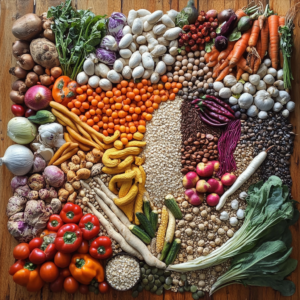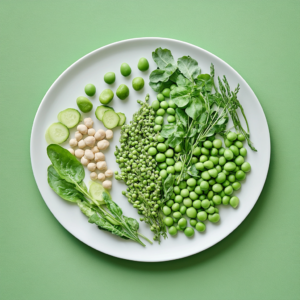Introduction
Hello, fellow vegan enthusiasts! I’m thrilled to share my journey and insights on how I fuel my active lifestyle with plant-based protein sources. As an active vegan, I know how challenging it can be to ensure our bodies receive the protein needed to support muscle repair, recovery, and overall performance. In this comprehensive guide, I will dive into why protein is so essential for active individuals, demystify the world of plant-based proteins, and offer practical advice on incorporating these nutrient powerhouses into your daily meals. Whether you’re a seasoned athlete or just beginning your vegan journey, this article is designed to equip you with the knowledge you need to optimize your nutrition and naturally enhance your performance.

I’ve experimented with countless recipes and meal plans, and I truly believe that with the right approach, you can meet—and even exceed—your protein needs without compromising your values. In the following sections, I’ll share detailed insights, scientific explanations, and personal experiences that have helped me thrive as an active vegan.
Why Protein is Essential for Active Vegans
Protein is the building block of life, crucial for repairing tissues, building muscle, and supporting a robust immune system. For active vegans like myself, protein isn’t solely about muscle gain; it plays a pivotal role in recovery, sustained energy, and overall wellness. I’ve experienced firsthand how a balanced intake of high-quality plant proteins can lead to faster recovery times and improved strength.
Research shows that active individuals often require a higher protein intake compared to those with a sedentary lifestyle. Many nutrition experts recommend that athletes aim for between 1.2 to 2.0 grams of protein per kilogram of body weight per day. This is essential for muscle repair after strenuous workouts and for supporting continuous growth and maintenance of lean body mass.
An interesting point to note is that protein is composed of amino acids, some of which are essential and must be obtained through our diet. Unlike animal proteins, many plant-based proteins can be slightly incomplete in their amino acid profiles. However, by consuming a diverse range of plant proteins throughout the day, you can easily obtain all the essential amino acids needed for optimum health. If you’re interested in a broader look at vegan nutrition, I highly recommend reading “10 Essential Vegan Nutrition Tips for a Healthier Life.”
Understanding Plant-Based Proteins
Plant-based proteins are derived from various sources such as legumes, nuts, seeds, grains, and even some vegetables. While animal proteins are typically complete (containing all nine essential amino acids), many plant proteins may lack one or more of these vital components. However, this is not a drawback; it simply means that eating a varied diet is key to ensuring you get a balanced amino acid profile.
I always emphasize the importance of dietary diversity. For example, pairing legumes with whole grains—like combining rice with beans—not only meets your protein needs but also enhances your intake of fiber, vitamins, and minerals. Modern cooking techniques, such as soaking, sprouting, and fermenting, can further boost the digestibility and nutrient availability of plant proteins.

Additionally, the bioavailability of plant proteins can be improved through proper preparation methods. Cooking, fermenting, or even blending ingredients can help unlock nutrients that might otherwise be less accessible. For those who are new to the concept of vegan nutrition, our post “Understanding Vegan Nutrition: What Every Beginner Should Know” provides an excellent starting point.
Top Plant-Based Protein Sources
Below, I’ll delve into the primary plant-based protein sources that have become staples in my diet. Each category offers unique benefits and can be easily incorporated into a variety of meals to suit different tastes and nutritional needs.
Legumes: The Powerhouses of Protein
Legumes are among the most nutrient-dense sources of protein available to vegans. Beans, lentils, chickpeas, and peas are not only rich in protein but also packed with fiber, vitamins, and minerals that support overall health. For instance, a cup of cooked lentils provides roughly 18 grams of protein, making them ideal for soups, salads, or even as a meat substitute in dishes like lentil loaf. Chickpeas, offering about 15 grams of protein per cooked cup, are perfect for creating creamy hummus or adding substance to stews and curries. Similarly, black beans and kidney beans are celebrated for their protein content as well as their high fiber levels, which help in maintaining steady energy during intense workouts.
I have incorporated a myriad of legume-based dishes into my weekly menu. Experimenting with various spices and herbs not only enhances the flavor but also makes these protein sources incredibly versatile.

Nuts and Seeds: Tiny Nutrient Bombs
Nuts and seeds are more than just a quick snack; they are nutritional powerhouses that contribute significantly to your daily protein intake. Almonds, walnuts, chia seeds, hemp seeds, and pumpkin seeds offer a rich supply of protein along with healthy fats, fiber, and antioxidants. For example, a small handful of almonds can provide a satisfying dose of protein, vitamin E, and monounsaturated fats, making them a perfect mid-day snack. Chia seeds are another favorite—they are rich in omega-3 fatty acids, fiber, and protein, and work wonderfully in smoothies, puddings, or as a binding agent in vegan baking.
Hemp seeds are particularly notable for their nearly perfect balance of essential amino acids, which makes them an excellent addition to any meal. Pumpkin seeds also deliver a robust nutrient profile, especially in terms of magnesium and zinc, which are essential for maintaining energy levels and muscle function.
Whole Grains: Beyond Carbs
Whole grains often get labeled solely as carbohydrate sources, but many of them are surprisingly high in protein. Grains such as quinoa, barley, oats, and brown rice contribute to a balanced vegan diet by providing both energy and essential amino acids. Quinoa is especially noteworthy because it is a complete protein, containing all nine essential amino acids. One cooked cup of quinoa offers about 8 grams of protein and is incredibly versatile for salads, bowls, or even breakfast porridge. Oats, when prepared as a hearty breakfast, supply fiber, protein, and slow-releasing carbohydrates that help sustain energy levels throughout the day. Brown rice, though slightly lower in protein content, pairs wonderfully with legumes to form a complete protein meal.
Soy-Based Options: Versatile Protein Solutions
Soy is one of the most well-known plant-based proteins and is celebrated for its flexibility in various dishes. Tofu, tempeh, and edamame are staples in many vegan kitchens. Tofu, available in different textures from silken to extra-firm, can offer anywhere between 10 to 20 grams of protein per serving. It readily absorbs flavors from marinades and spices, making it suitable for stir-fries, scrambles, or even grilled dishes. Tempeh, with its nutty flavor and firm texture, contains about 21 grams of protein per 100 grams and is excellent in sandwiches, salads, or mixed into a hearty stir-fry. Edamame, which are young soybeans, are not only fun to eat but also serve as a quick and convenient protein boost.
Soy-based foods are rich in isoflavones, compounds that have been linked to benefits such as improved heart health and enhanced bone strength. Integrating these foods into your routine is a fantastic way to diversify your protein sources.
Other Plant-Based Protein Sources
Beyond the common categories, there are several other plant-based protein sources that add variety and depth to your diet. Seitan, often referred to as “wheat meat,” is made from gluten and is exceptionally high in protein. Its chewy texture makes it an excellent meat substitute in many recipes. Spirulina, a blue-green algae, is a complete protein and can be easily blended into smoothies or juices for an extra nutritional boost. Even certain vegetables like spinach, broccoli, and Brussels sprouts contribute to your protein intake, although in smaller amounts. Finally, plant-based protein powders, derived from sources like pea, rice, or hemp, can be a convenient addition to your diet, especially for post-workout recovery or when you’re on the go.
Meal Planning and Combining Proteins
One of the secrets to a balanced vegan diet is strategic meal planning. By combining different plant-based protein sources throughout the day, you can easily ensure that you receive all the essential amino acids your body needs. I often plan my meals ahead of time, creating a rotation that includes a variety of legumes, grains, nuts, and soy products.
For example, a simple yet effective approach is to pair legumes with whole grains. A classic combination like black beans and quinoa not only tastes great but also offers a complete amino acid profile. I also incorporate protein-rich snacks like a handful of almonds or a chia pudding between meals to keep my energy levels steady. In addition, diversifying your meals can be as simple as adding a different protein source to your salad or stir-fry each day. These strategies help prevent monotony and ensure your body gets a wide range of nutrients.
I often encourage readers to experiment with their own combinations and discover what works best for their taste and lifestyle. For further inspiration on meal planning, you can explore “Vegan Meal Prep Ideas to Simplify Your Week,” where I share some of my favorite weekly routines.
Supplementing Your Diet
While whole foods should always form the cornerstone of your diet, there are times when supplements can be beneficial—especially for those with demanding training schedules. I sometimes incorporate plant-based protein powders into my regimen for a quick, convenient post-workout protein boost. These powders, available in varieties such as pea, rice, or hemp protein, help bridge any nutritional gaps on particularly busy days.
It’s important to choose supplements that are free from additives and artificial ingredients. Personally, I opt for high-quality protein powders that have been independently tested for purity and efficacy. Aside from protein powders, other supplements such as vitamin B12, vitamin D, and omega-3 fatty acids (often derived from algae) are essential for rounding out a vegan nutritional profile. However, I always recommend consulting with a healthcare provider or a nutrition specialist before introducing any new supplements into your routine.
Practical Tips for Integrating Protein into an Active Vegan Lifestyle
Integrating sufficient protein into your daily meals doesn’t have to be complicated. Here are some practical tips that have worked wonders for me in maintaining my energy and strength throughout the day:
Plan Ahead – I dedicate a few hours each weekend to meal prepping. I cook large batches of legumes, grains, and roasted vegetables so that nutritious options are always available during hectic weekdays. This strategy minimizes last-minute stress and ensures that I never skip a protein-packed meal.
Mix and Match – Variety is key. I keep my diet interesting by mixing different protein sources in my meals. For example, a hearty salad might include chickpeas, quinoa, and a sprinkling of hemp seeds, while a stir-fry might combine tofu with a medley of vegetables and brown rice. Experimenting with various herbs and spices further enhances the flavor profile of these dishes.
Snack Smart – Healthy snacking is crucial. I often reach for a handful of mixed nuts, a protein bar, or even a smoothie enriched with plant-based protein powder. These snacks not only provide a quick protein fix but also help keep my energy levels stable between meals.
Keep it Simple – Sometimes the simplest meals are the most effective. A bowl of oatmeal topped with almond butter and a sprinkle of chia seeds can be as nourishing as a gourmet dish. The key is to ensure that every meal contains a balance of protein, healthy fats, and carbohydrates.
Stay Hydrated – I cannot stress enough the importance of hydration. Water is essential for proper digestion and nutrient absorption, especially when you’re consuming a high-fiber, protein-rich diet. Drinking enough water throughout the day supports overall health and maximizes the benefits of your protein intake.
Listen to Your Body – Everyone’s nutritional needs are unique. I pay close attention to my body’s signals—if I feel fatigued or notice slow recovery times, I adjust my protein intake accordingly. It’s important to remember that the goal is to feel energized and strong, so personalizing your diet based on your body’s feedback is key.
For more creative and quick meal ideas, do check out “Quick and Delicious Vegan Recipes for Busy Weeknights.” This resource has been invaluable in helping me discover new recipes that fit perfectly into my busy schedule.
Internal and External Resources for Further Learning
Continuous learning is crucial in the pursuit of optimal health and performance. I’ve compiled a list of resources that have significantly contributed to my understanding of plant-based protein and vegan nutrition. These include both internal resources from our blog and external, scientifically-backed sources.
Internal Resources:
• “10 Essential Vegan Nutrition Tips for a Healthier Life” provides a foundational guide on vegan nutrition and offers tips that have helped me build a balanced diet.
• “Mastering Vegan Cooking: Top Tips for Beginners” is another excellent resource that has inspired me to experiment with new recipes and cooking techniques.
• “Your Guide to Essential Vegan Supplements for Optimal Health” dives deeper into the supplements that can help fill nutritional gaps.
I highly recommend checking out this informative YouTube video from a renowned nutrition channel that delves into the science behind plant-based proteins. It provides excellent insights and practical tips to complement the advice shared in this article: Watch on YouTube. Additionally, credible sources such as Nutrition.gov and PubMed offer a wealth of peer-reviewed research on vegan nutrition that can further enhance your understanding.: For those interested in obtaining more information on this topic, we recommend this complete course which covers several interesting topics related to veganism.
Frequently Asked Questions (FAQ)
Q1: How much protein should I consume daily as an active vegan?
A1: Protein needs vary based on factors such as activity level, age, and body weight. Generally, active individuals may require between 1.2 to 2.0 grams of protein per kilogram of body weight per day. It’s always a good idea to consult with a nutritionist for personalized recommendations.
Q2: Can I obtain all essential amino acids from plant-based sources?
A2: Yes, by consuming a diverse range of plant proteins throughout the day—such as legumes, whole grains, nuts, and seeds—you can easily obtain all the essential amino acids your body needs. The key is to combine different sources to create a complete protein profile.
Q3: What are the best plant-based protein sources for muscle recovery?
A3: Legumes (like lentils and chickpeas), soy-based products (tofu, tempeh, edamame), and protein-rich whole grains (such as quinoa) are excellent for muscle recovery due to their high protein content and nutritional benefits.
Q4: How can I ensure that plant proteins are easily digestible?
A4: Proper preparation methods like soaking, sprouting, fermenting, or cooking can improve the digestibility of plant proteins. Fermented foods, such as tempeh, are particularly beneficial for enhancing nutrient absorption.
Q5: Should I consider using protein supplements?
A5: While whole foods should be the foundation of your diet, protein supplements—such as high-quality plant-based protein powders—can be very convenient for post-workout recovery or on busy days. Always choose products free from unnecessary additives and consult a professional if needed.
Q6: Are there any other important nutrients I should focus on as an active vegan?
A6: Absolutely. In addition to protein, vitamins and minerals such as vitamin B12, vitamin D, iron, calcium, and omega-3 fatty acids are essential for overall health. Ensuring a varied diet or incorporating the right supplements can help maintain optimal nutritional balance.
Conclusion and Final Thoughts
In conclusion, being an active vegan doesn’t mean you have to compromise on your protein intake. There is an abundance of plant-based protein sources that are not only nutritious but also versatile and delicious. Whether it’s the hearty legumes, versatile soy products, nutrient-packed nuts and seeds, or even protein-enriched whole grains, each offers unique benefits that can be tailored to support your active lifestyle.
I hope this comprehensive guide has empowered you to experiment with new recipes, optimize your meal planning, and confidently fuel your body with the high-quality protein it needs. Remember that diversity is the secret to a balanced diet. By mixing and matching different protein sources, you ensure that your body receives a complete range of amino acids, ultimately leading to better performance, faster recovery, and overall enhanced wellness.
Before you go, I encourage you to explore other posts on our blog to expand your vegan culinary repertoire. If you’re curious about boosting your energy naturally, do check out “Boost Your Energy with a Vegan Diet” and for budget-friendly tips, visit “Budget-Friendly Vegan Meals That Don’t Sacrifice Taste.” Your journey towards optimal health is continuous, and I’m here to support you every step of the way.
For those interested in obtaining more information on this topic, we recommend this e-book.
Thank you for reading and investing your time in learning more about plant-based protein sources. Stay active, remain curious, and enjoy every step of your vegan journey. Your body will thank you for it!